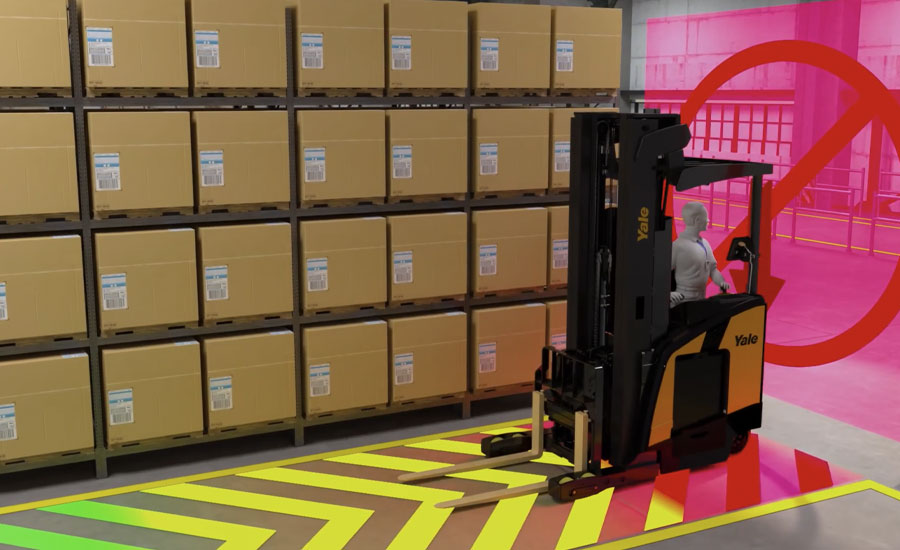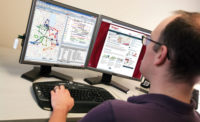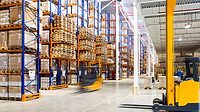Telematics aid beverage operations inside and out
Future for telematics will see predictive insights take greater focus

Image courtesy of Yale Lift Truck Technologies
No one enjoys getting lost, including fictional characters. In the “Arthur” episode titled “Fernfern and the Secret of Moose Mountain,” classmates Francine, the experienced hiker, and Fern, the neophyte hiker, are paired together on group hike. In Francine’s eagerness to break her record to the top of the mountain, the duo lose their map and end up taking a shortcut, resulting in swamps, lost shoes and more mishaps. Using their own skill sets the girls make it to the top and Francine beats her record by one minute.
In beverage operations, drivers and equipment operators are not trying to beat personal records, but still are striving to deliver product as efficiently and safely as possible, and are turning to solutions like telematics to realize those goals.
However, the capabilities of modern telematics systems extend far beyond global positioning systems that they often are associated with.
“Telematics has evolved from a novel technology displaying a vehicle’s real-time location on a map to a mission-critical system for businesses that operate commercial fleets,” says Michael Bloom, director of connected truck technologies at Houston-based Mitsubishi Logisnext Americas. “In today's market, telematics offers a comprehensive suite of tools and insights, making it indispensable for companies with a fleet component.”
Detailing the vast capabilities of telematics systems, Bloom notes that they offer tangible and intangible benefits to the beverage industry and its supply chains.

“They provide insights into fleet efficiencies, streamline field-based workflows, ensure regulatory compliance, reduce fuel and preventative maintenance costs, and offer visibility into driver and operator behaviors,” he says. “These systems also serve as a valuable resource for customer service and can ‘replay’ historical data to reconstruct events.”
Yet, with all of this information, operations personnel can become overwhelmed, Bloom explains.
“Companies frequently struggle to make sense of the flood of data, either because they don’t have the time to analyze it or because they're unsure which metrics are critical and what corresponding actions to take,” he says. “As a result, many businesses resort to using telematics only in specific scenarios, like reconstructing incidents, generating generic monthly fleet reports, or optimizing workflow.”
Bloom elaborates that the true potential of telematics is the systems abilities to process and analyze data in real-time, allowing decision-makers to gain actionable insights.
“The next generation of telematics solutions will do more than simply collect data ― they will use artificial intelligence and machine learning to interpret it and recommend specific actions,” Bloom says. “This level of automation allows users to manage their fleets more effectively, providing a comprehensive view of their operations by integrating data from various applications.
“With this integrated approach, telematics users will know precisely what they need to do, when they need to do it, and why,” he continues. “This evolution in telematics technology, driven by AI, isn’t just a distant dream — it’s an imminent reality that’s set to revolutionize fleet management.”
Telematics in-house
Although the realized results of telematics for fleet operations is well-known, experts note that systems also can be a vital asset in warehouse operations, particularly in the face of SKU proliferation.
“Simply put, consumers have sought greater variety in beverage selections ― more sizes, more flavors and different quantities,” says Mike Kennedy, executive business manager at Yale Lift Truck Technologies, Greenville, NC. “In fact, beverage operations are seeing 2-8% more new product introductions than the next leading category, meaning more SKUs to process, store and distribute. Consumers are also expecting greater convenience and swift availability of their desired SKUs, whether they’re purchasing in stores or online. This places greater pressure on beverage operations to secure equipment that can help them efficiently store, pick and deliver these SKUs.”
Ryan Schoelerman, product manager of iWAREHOUSE Telematics for The Raymond Corp., Greene, NY, echoes similar sentiments.
“As the beverage industry continues to have exponential growth of SKUs driven by the continual addition of more variability, tastes and trends to the beverage market, more SKUs add complexity to warehousing and distribution operations,” he says. “This variability has the potential to impact overall costs and efficiency. Variability also can affect timely delivery of cases and pallets to the right retailers to meet consumer demands of increased accessibility, speed and an overall better consumer experience.”
Given this complexity, the data collection with a warehouse telematics system can assist decision-makers.
“Telematics systems can provide real-time data for monitoring forklifts in the warehouse and the data to help streamline operations, enhancing efficiency and reliability,” Schoelerman says. “Raymond’s iWAREHOUSE telematics system has been designed to easily integrate with any business operation, including beverage distribution, by providing customers detailed data analytics reports or by using application programming interfaces to integrate telematics data into a warehouse management system.”
Beyond information to streamline operations, telematics systems also can support safer working operations, experts note.
“With OSHA estimating that nearly 100,000 injuries involving forklifts occur annually, warehouses are constantly looking for tools that can help support safety efforts, especially as employee turnover and inexperienced operators exacerbate these challenges,” says Joe Koch, sales manager of emerging technology at Yale Lift Trucks. “Integrating technology like telematics or operator assist solutions can help facilities move their entire business forward ― whether that’s reducing labor costs, boosting productivity or meeting other goals.
“For instance, Yale Vision telemetry provides customers with insights and controls to improve operator behavior, control access to equipment, confirm pre-shift checklist completion, and monitor equipment and operator utilization,” he continues. “With a telemetry system, operator access controls can use key cards to limit equipment access to only operators with the proper licensing and training, and track performance and training expiration for each operator. Digital safety checklists can disable truck use until the operator has completed the standard OSHA pre-shift checklist or other specific industry mandated checklists.”

With telemetry systems, Koch notes that impact cameras can be integrated to capture footage of events to help improve safety.
“The impact camera provides warehouse managers with greater visibility to help improve safety, increase efficiency and reduce costs,” he explains. “The camera syncs with the impact detection system so when a critical impact occurs, video footage of three minutes before and after is automatically saved.
“The dual cameras provide large panoramic views in both the front and rear, conveniently powering on and off automatically with the lift truck,” Koch continues. “Full HD video during playback captures fast-moving content, even in harsh and low light environments, to help validate impacts and identify product damage and inventory shrinkage issues.”
Raymond’s Schoelerman adds that the latest generation of telematics systems can easily integrate into forklifts and other technologies, allowing for an interconnected ecosystem.
“Raymond’s iWAREHOUSE telematics system is a scalable solution supporting a number of layered technologies, including the iWAREHOUSE Integrated Tether System, operator assist solutions, and detailed battery monitoring and reporting for both lead-acid and lithium-ion batteries,” he says. “Operations can add enterprise-level functionality to gain insights from additional data points, such as load sensing, task selection and labor management.”
Driving returns
Whether it is for delivery vehicles or warehouse equipment, the return-on-investment for telematics systems will vary based on the scale and goals, experts note. However, efficiency benefits gained for operations will quickly be realized.
“Return on investment (ROI) in telematics is not a one-size-fits-all metric; each business will experience unique benefits,” Mitsubishi’s Bloom says. “However, certain factors typically drive ROI across the board. Telematics offers a clear view into operational areas where efficiency gains can be made, such as monitoring load/unload times and optimizing transportation within a facility. This visibility helps reduce costs and improve performance.”
Bloom adds that fuel and power savings are easily achieved by reduced idle times and efficient vehicle movement. The lifespan of trucks and other assets also can be extended as telematics enable preventative care.
Similar to in the warehouse, the risk reduction plays into ROI for fleet telematics. “Telematics also contributes to risk mitigation, which in turn lowers insurance premiums and repair expenses,” Bloom says. “Labor costs decrease thanks to streamlined workflows, improved staffing strategies, and reduced overtime. Asset utilization is another area of improvement, with telematics enabling better fleet utilization and resource allocation.
“Overall, telematics can drive top- and bottom-line revenue growth by increasing capacity and uncovering new opportunities to maximize existing resources,” he continues. “While the specific ROI will vary from one business to another, these are the common drivers that telematics brings to the table.”
Raymond’s Schoelerman also points to the varying factors that will contribute to a ROI, but highlights the actionable insights that can be realized immediately.
“The typical ROI for a telematics system varies for each operation and its goals, although warehouse managers immediately gain data visibility into their business and forklift operators, which allows them to manage their personnel and equipment more efficiently and effectively,” he says. “Fleet managers can utilize Raymond’s iWAREHOUSE data analytics to make informed decisions on whether to retain, remove, reallocate or replace equipment, and iWAREHOUSE data can be easily integrated into a customer’s WMS to also drive ROI.”
Meanwhile, Yale’s Koch pinpoints several areas in which telemetry systems can help beverage operations experience a ROI: cost reduction, efficiency improvements, risk mitigation and customer satisfaction.
“The specific ROI of a telemetry system will depend on the unique circumstances and objectives of each organization,” he says. “It’s essential to conduct a thorough cost-benefit analysis, considering factors such as upfront investment costs, ongoing operational expenses, expected savings or revenue gains, and the projected timeline for realizing returns. Additionally, ROI calculations should account for intangible benefits such as improved decision-making, enhanced competitiveness, and greater organizational agility enabled by telemetry technology.”
However long it will take beverage operations to see a ROI with telematics systems, the path seems clear that the technology is a growing force in delivery and warehouse management.
Looking for a reprint of this article?
From high-res PDFs to custom plaques, order your copy today!






